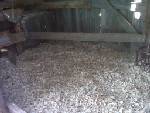Quote:
Pine, spruce, fir, hemlock are really about the best, performance-wise. Hardwood shavings need to be watched closely b/c they are more apt to mold. The major issue with getting shavings from a lumber mill is that their quality is quite often poorer and always more *variable* than bagged shavings. Sometimes you can luck into a great source, in which case yay, but oftentimes you will get at least some loads that are real dusty or real woodchippy and don't make very good bedding.
Honestly, unless you are in unusual circumstances you probably needn't go through a whole lot of bedding (like bags per months) unless you *want* to - there are ways of arranging your life so's not to blow through excessive amounts of shavings. In which case driving a few extra miles to get *good quality, bedding type* bagged shavings can be very worthwhile if the closer mill shavings are not excellent bedding-type quality.
Do you not have a feedstore (farm store) closer to you? ALL feed stores should have bags of shavings for bedding, I've never seen one that doesn't anyhow. It won't be listed on their website and quite possibly not displayed on their shelves, but if you ask they will be happy to sell you some out of a semi trailer out back, or some such arrangement.
Good luck, ahve fun,
Pat
Pine, spruce, fir, hemlock are really about the best, performance-wise. Hardwood shavings need to be watched closely b/c they are more apt to mold. The major issue with getting shavings from a lumber mill is that their quality is quite often poorer and always more *variable* than bagged shavings. Sometimes you can luck into a great source, in which case yay, but oftentimes you will get at least some loads that are real dusty or real woodchippy and don't make very good bedding.
Honestly, unless you are in unusual circumstances you probably needn't go through a whole lot of bedding (like bags per months) unless you *want* to - there are ways of arranging your life so's not to blow through excessive amounts of shavings. In which case driving a few extra miles to get *good quality, bedding type* bagged shavings can be very worthwhile if the closer mill shavings are not excellent bedding-type quality.
Do you not have a feedstore (farm store) closer to you? ALL feed stores should have bags of shavings for bedding, I've never seen one that doesn't anyhow. It won't be listed on their website and quite possibly not displayed on their shelves, but if you ask they will be happy to sell you some out of a semi trailer out back, or some such arrangement.
Good luck, ahve fun,
Pat





